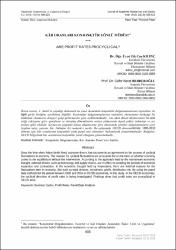| dc.contributor.author | Kılınç, Efe Can | |
| dc.contributor.author | Berberoğlu, Cafer Necat | |
| dc.date.accessioned | 2020-06-25T14:32:49Z | |
| dc.date.available | 2020-06-25T14:32:49Z | |
| dc.date.issued | 2018 | |
| dc.identifier.citation | Kılınç, E. C., Berberoğlu, C. N. (2018). Kâr Oranları Konjonktür Yönlü Müdür?. Akademik Araştırmalar ve Çalışmalar Dergisi, 10(19), 606 - 621. | en_US |
| dc.identifier.issn | 1309-3762 | |
| dc.identifier.issn | 2149-1585 | |
| dc.identifier.uri | https://app.trdizin.gov.tr/publication/paper/detail/TXpBNU5EVTBOQT09 | |
| dc.identifier.uri | https://hdl.handle.net/20.500.12587/193 | |
| dc.description.abstract | İktisat teorisi, A. Smith’in yaşadığı dönemden bu yana ekonomide konjonktür dalgalanmalarının kaynakları ileilgili görüş birliğine varabilmiş değildir. Konjonktür dalgalanmalarının nedenleri, ekonominin herhangi birmüdahale olmaksızın dengeye gelip-gelmemesine göre açıklanmaktadır. Ana akım iktisat düşüncesinin öncülükettiği yaklaşıma göre, genişleme ve daralma dönemlerinin ortaya çıkmasında dışsal şoklar (teknoloji ve arzşokları gibi) etkilidir. Keynesyen çizgideki iktisat düşüncesine göre ekonomide görülen dalgalanmaların içsel(toplam talep, yatırım, kâr, bölüşüm vb.) nedenleri vardır. Bu çalışmada, OECD ekonomilerinde, 1995-2016dönemi için, kâr oranlarının konjonktür yönü panel veri yöntemleri kullanılarak araştırılmaktadır. Bulgular;OECD bölgesinde kâr oranlarının konjonktür yönlü olduğunu göstermektedir. | en_US |
| dc.description.abstract | Since the time when Adam Smith lived, economy theory has not come to an agreement on the sources of cyclicalfluctuations in economy. The reasons for cyclical fluctuations are accounted for on the basis of whether economycomes to the equilibrium without the intervention. According to the approach lead by the mainstream economicthought, external shocks, such as technology and supply shocks, are in effect on creating the periods of economicexpansion and contraction. In the economic thought held by Keynesians, there are internal reasons for theflactuations seen in economy, like such as total demand, investment, profit, distribution etc. By using the paneldata methods for the period between 1995 and 2016 in OECD economies, In this study, in the OECD economies,the cyclical direction of profit rates is being investigated. Findings show that profit rates are procyclical inOECD area. | en_US |
| dc.language.iso | tur | en_US |
| dc.rights | info:eu-repo/semantics/openAccess | en_US |
| dc.subject | İş | en_US |
| dc.subject | İşletme Finans | en_US |
| dc.subject | İktisat | en_US |
| dc.subject | Çevre Çalışmaları | en_US |
| dc.subject | Tarih | en_US |
| dc.subject | Uluslararası İlişkiler | en_US |
| dc.subject | İşletme | en_US |
| dc.subject | Siyasi Bilimler | en_US |
| dc.subject | Kamu Yönetimi | en_US |
| dc.subject | Kentsel Çalışmalar | en_US |
| dc.title | Kâr Oranları Konjonktür Yönlü Müdür? | en_US |
| dc.title.alternative | Are Profit Rates Procyclical? | en_US |
| dc.type | article | en_US |
| dc.contributor.department | Kırıkkale Üniversitesi | en_US |
| dc.identifier.volume | 10 | en_US |
| dc.identifier.issue | 19 | en_US |
| dc.identifier.startpage | 606 | en_US |
| dc.identifier.endpage | 621 | en_US |
| dc.relation.journal | Akademik Araştırmalar ve Çalışmalar Dergisi | en_US |
| dc.relation.publicationcategory | Makale - Ulusal Hakemli Dergi - Kurum Öğretim Elemanı | en_US |
















